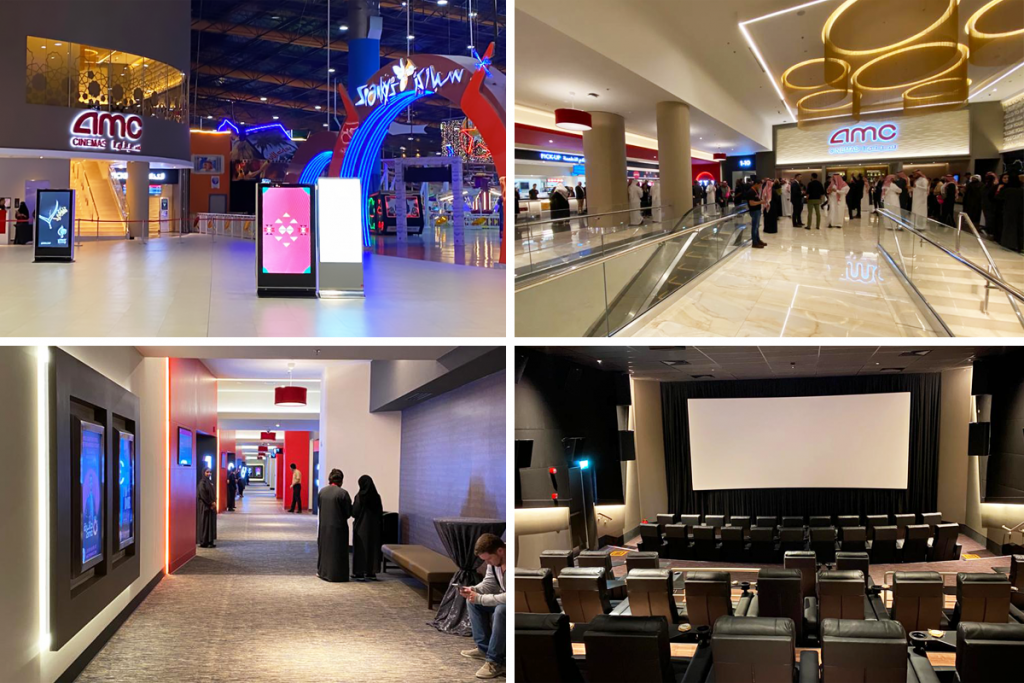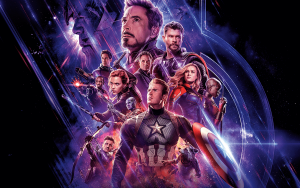AMC Cinemas opened its newest location in Riyadh at Panorama Mall on Monday 16th December 2019.
The cinema is home to 10 screens with a total of 793 luxe reclining seats.
In celebration of the opening of the new cinema, AMC Cinemas held a special event at Panorama Mall where guests were treated to a sneak peek of the facility – a chance to sample the food on offer and a screening of their choice of the latest films in cinema (Dark Water, Jumanji: The Next Level and Ford v Ferrari).

Declaring the cinema to be officially open, Adom Aron – CEO of AMC, revealed AMC’s plans in the Kingdom. “We now have two theaters open in Riyadh, but we expect to open between eight and ten theatres by June, between 12 and 20 theatres next year, and 50 theatres in the next three, four years, and we expect to be the biggest and most luxurious cinema operator in Saudi Arabia,” he said.
Mishal Alsowayan – Marketing Manager at AMC, added: “We’re very happy to open AMC Panorama, and we’re looking forward to opening more and more locations soon.”
Panorama Mall is AMC’s second location in Saudi Arabia, with the first located at King Abdullah Financial District (KAFD) – also the first cinema to officially open in the country on 18th April 2018. KAFD was recently renovated to feature 405 seats which include luxe recliners and plush rockers.
The cinema exhibitor presently operates 11 screens across 2 locations in KSA.
Tickets to movie sessions at Panorama Mall, as well as the revamped KAFD location are available on AMC’s official website.
Motivate Val Morgan congratulates AMC Cinemas on its opening at Panorama Mall and warmly welcomes this new location to our cinema circuit. Contact us for cinema advertising opportunities in KSA.
Sources: Arab News, BroadcastPro and AMC Cinemas
Related Articles:
Motivate Val Morgan Welcomes AMC Cinemas to its Circuit in KSA
The gang is back but the game has changed!
In Jumanji: The Next Level – releasing 12th December 2019, the players return to the world of Jumanji to rescue one of their own, only to discover that nothing is as they expected.
The players – Spencer, Martha, Smolder Bravestone, Fridge and a few new faces, brave parts unknown and unexplored (from the arid deserts to the snowy mountains) in order to escape the world’s most dangerous game!
Watch the trailer of the Jumanji: The Next Level 2019:
Here’s what we know about the movie so far:
Rating:
The MPAA has yet to announce an official rating, but it will probably be PG-13. The first Jumanji in 1995 was PG, but this is more of a direct sequel to Jumanji: Welcome to the Jungle (2017), which earned a PG-13 rating in 2017 for adventure action, suggestive content and some language. It can be presumed that the movie’s rating in the Middle East will end up being PG-15 for cinemagoers.
Will Jumanji: The Next Level Connect to the previous films?
It was initially thought that Jumanji: Welcome to the Jungle would be a reboot of the Jumanji franchise. Instead, it was a sequel to the 1995 Robin Williams movie. It didn’t have many references to the original, but it was clear that it was set in the same universe. Director Jake Kasdan states he plans to have Jumanji: The Next Level connect to both previous films, but especially Welcome to the Jungle.
Director:
Jake Kasdan has directed numerous theatrical films such as: Zero Effect (1998), Walk Hard: The Dewey Cox Story (2007), Bad Teacher (2011) and Jumanji – Welcome to the Jungle, as well as episodes of TV shows such as: Freaks and Geeks, New Girl and Fresh Off the Boat.
In 2006, Kasdan received his first Golden Globe nomination for Walk Hard: The Dewey Cox Story (2007) – Best Original Song (shared with John C. Reilly, Judd Apatow, and Marshall Crenshaw).
Kasdan’s proven ability with smart, teen-based comedy, earned him the directing job for Orange County (2002) – starring Jack Black, Colin Hanks and Schuyler Fisk.
Mostly known for R-rated comedies, Kasdan came out of nowhere to prove he could helm a PG-13 action-comedy with major stars Dwayne Johnson, Kevin Hart, Jack Black, Karen Gillan, and Nick Jonas. Jumanji: Welcome to the Jungle (2017) also directed by Kasdan, went on to become one of Sony’s biggest box-office hits ever.
Hailed as the ‘Helmer of Jumanji series’, Kasdan states the upcoming installment will sew in even more nods to the original Robin Williams classic.
Who’s returning in Jumanji: The Next Level?
Almost every major player from Jumanji: Welcome to the Jungle will appear in Jumanji: The Next Level, although we’ll get to see several of them in brand-new light.
Dr. Smolder Bravestone
In Jumanji: Welcome to the Jungle (2017), Dwayne Johnson got to play against his type even though the person playing his avatar was nerdy, allergy-prone Brantford High School student Spencer. However, in the sequel, Johnson’s game avatar (Smolder Bravestone) will play to his literal strengths – a confident and clearly very muscular archaeologist and international explorer.
Professor Sheldon “Shelly” Oberon
Jack Black had a fun role in Welcome to the Jungle as Professor Sheldon Oberon. His cartographer was played by popular, self-absorbed pretty girl Bethany, who was not expecting to be Black’s ‘overweight middle-aged man’. This time round, as seen in the trailer of The Next Level, Fridge (Kevin Heart) ends up in the body of the ‘old, fat dude’ avatar.
Ruby Roundhouse
Karen Gillan plays “killer of men” Ruby Roundhouse, a fierce martial arts and dance fighting expert. Her avatar was played by shy high school student Martha.
Jefferson “Seaplane” McDonough
Nick Jonas was something of a surprise addition to the group as avatar pilot Jefferson ‘Seaplane’ McDonough. He was the avatar of gamer Alex Vreeke – a teen who got stuck in the Jumanji game in 1996. This storyline was a direct tie to the original 1995 Jumanji film, where Alex had taken shelter in the game world in a house built by the previous Jumanji player, Alan Parrish, portrayed in film by Robin Williams.
New characters in Jumanji: The Next Level:
Joining the cast for Jumanji: The Next Level are comedic acting legends Danny DeVito and Danny Glover, playing Spencer’s grandfather, Eddie Gilpin, and his friend, Milo Walker, respectively.
If The Next Level follows the same format as Welcome to the Jungle, we don’t expect to see DeVito and Glover on screen for very long, but it looks like the characters will still have a significant presence in the movie after they accidentally enter the game and wind up controlling the avatars portrayed by Dwayne Johnson and Kevin Hart.
Also coming aboard are Dania Ramirez (Once Upon a Time) and Awkwafina (Crazy Rich Asians), both in undisclosed roles. While Ramirez doesn’t appear in the trailer at all, the brief glimpse we get of Awkwafina suggests that she’ll be playing a character within the game.
The Hollywood Reporter states that Awkwafina’s role is ‘key’ and ‘significant’, leading us to guess that she’s likely either an avatar for one of the players — possibly Spencer, Bethany, or even Alex — or she’s the game’s new villain.
Jumanji: Welcome to the Jungle (2017) did $964,496,193 at Worldwide Box Office proving to be one of the leggiest (and most unexpected) blockbuster phenomenon’s in recent memory. In the UAE, the film ran for a total of 22 weeks and did over 684K admissions – 2nd highest ranking movie in UAE’s Top 10 Movies of 2017.
Boxoffice Pro is projecting Jumanji: The Next Level to make $66 – 76 million in its opening weekend in the US.
Motivate Val Morgan forecasts over 600K admissions for Jumanji: The Next Level.
Don’t miss out on advertising alongside this fun and comedic blockbuster. Contact a member of our sales for more information on cinema advertising options.
Sources: Looper, The Numbers, Boxoffice Pro, Meaww and MVM Analysis
Cinema is appealing to a more diverse group of consumers than ever before, making it an attractive platform for many brands to utilize. In order to ensure brands reach and engage their target audience effectively with their cinema promotion, there are certain consumer trends to be kept in mind, considering their potential impact on the outcome of a campaign.
The following article was published on LinkedIn by Casey Story – Organization Development Professional | Learning & Development Specialist | Sales Trainer & Coach
Kurt Wagner from Recode Media wrote an article stating that, “2019 will mark the first-time digital ad spend in the US outpaces TV and print combined.” Marketers will attest to this trend as there is a noticeable change in expectations among clients. Media planning conversations use to focus mostly around aspects including: Audience, engagement, reach, recall, like-ability, however the stakes have been shifting since 2008. Which most will remember as the year we all started walking around with cash registers in our pockets (personal smartphones).
Shifting of expectations from brands are steering agencies and media sales professionals to steer towards a ‘Positive Business Outcome’ approach to their media strategy. These teams are now focused on identifying the right consumers, reaching them in the right environment, engaging with them at the right time, and on the right devices to achieve and prove delivery of the KPI’s set forth by their clients.
While digital advertising allows brands to achieve several of these key components in the new outcome-based approach to planning, there are several considerations including: identifying the right consumers, reaching them in the right environment and engaging with them at the right time, that must still be supported by other channels in the traditional media space.
The following are three US consumer trends in 2019/2020 that make cinema advertising a more viable channel than ever to support brand goals:
Subscription Movie Going is Still Alive
Similar to blockbuster, taxi services and the music industry, the movie going industry did not feel a major disruption of their consumer’s expectations for a long period of time. The model was straightforward: negotiate with studios to fill theaters and auditoriums with blockbuster hits, sell tickets and concessions, invest in capital improvements that enhance the overall experience if/when needed. The main purpose was that the content on screen should be enough to encourage consumers to spend $10-20 dollars per ticket to see the films. Here’s where MoviePass makes its entrance.
The long-term arithmetic reflected in MoviePass’ model made it clear that without improved compensation from the circuits, the company was working on both borrowed time and money. As we know, the negotiation never happened, and MoviePass has been written down by its holding company.
The low-cost subscription model that MoviePass introduced however dramatically changed the consumer expectation regarding the cost of going to the movies. For the first time in years the exhibitors (Cinemark, Regal, AMC) have had to adjust their pricing strategy and are introducing subscription plans of their own. These actions have been well received by consumers. AMC recently announced that since launching their Stubbs A-List program (a $19.95 monthly subscription) in June of 2018, they have enrolled over 700,000 members.
This trend is important for advertisers considering cinema campaigns, because the data shows that when consumers have access to lower priced movie tickets, they see more movies. In the same article published in Variety, AMC noted that Stubbs A-List members had accounted for over 14 million movie ticket sales in the same amount of time.
Cinemark, Regal, and regional affiliates throughout the US are all working to finalize or develop their own subscription-based models to adapt to this shift in consumer expectation. What this means for advertisers is that passionate movie goers, those same consumers that drive 73% of spending in the US will be coming out in record numbers to their local movie theaters throughout 2019 because for the first time in years, they have a more affordable way of doing so.
Hollywood’s Franchise Era
The question, “When will Hollywood introduce us to new stories?” often rings in the minds of movie-goers alike. Ben Fritz’s book The Big Picture – The Fight for the Future of Movies answers this and discusses Hollywood’s shift towards the ‘franchise movie model’.
The reality is most consumers want two things when they choose to go to the movies:
Consumers may argue that they would prefer more adult dramas, romantic comedies, horror films, etc. However, the facts (historical ticket sales), reveal otherwise.
Looking at 2019’s slate of films, it is safe to say that we are in the heart of the Hollywood franchise era. The opportunities to experience something larger than life and culturally relevant are already driving record box office sales.
Captain Marvel (2019) made a total of $1,126,129,839 at the Worldwide Box Office. While remakes of popular Disney classics have been making cinema rounds. Classics such as: Dumbo made a total of $347,866,307 since its release in March 2019. Cinema-goers have also witnessed a rise in live-action remakes of popular Disney films this year, with movies such as The Lion King which made a whooping $1,638,761,919 at the box-office (to date). Whereas, the live-action version Aladdin’s live action version made a total of $1,037,017,346 since its release in May 2019.
From the Marvel Universe, the concluding film of the franchise- Avengers: End Game broke records at the box-office banking a total of$2,795,473,000 and continued to run in cinemas for 20 weeks across cinemas in the US.
The last quarter of the year holds great promise for the box office with mega sequels such as Frozen II, Jumanji: The Next Level and the concluding film of the Star Wars series: Star Wars: The Rise of Skywalker soon to release across cinemas worldwide.
Advertisers considering cinema campaigns should look closely at the historical success of the franchise model in domestic ticket sales. In the last four years, the highest grossing movies yearly in the US have come from within a franchise. This trend appears to continue throughout 2019. With the increased occurrence that moviegoers will be visiting theaters due to: Lower priced subscription service tickets and quality of content, advertisers have a unique opportunity to extend their reach among this audience year round.
Content Marketing: A Driving Force for Customer Connections
As digital spending eclipses traditional media spend this year, the digital marketplace has certainly become increasingly noisy. When adopting a positive business outcome marketing strategy, the goal is less about a brand’s ability to yell louder and more often than their competition. The goal, hence must shift, and brands must identify innovative ways to engage with their audience in an authentic manner, a trend that is leading the shift toward content marketing.
There are generally two approaches to developing a content marketing strategy:
When a brand has done well adopting either strategy, they pull their audience to their message instead of simply pushing more content into an already crowded marketplace. The impressions delivered from a content marketing strategy are much more valuable because customers actively seek out the content and actively share the message to other, like-minded, potential consumers.
Cinema is one of the last channels available for brands to tell an authentic story, at scale, in an environment with no ad skipping devices, and in front of consumers looking to be entertained.
Content marketing pieces delivered in this environment cut through the noise. Campaigns resonate with consumers, and the transparency of the cinema platform provides piece of mind for brands seeking to reclaim bot served impressions and eliminate wastage of advertising resources.
Are these trends similar in the Middle East?
Movie Ticket Offers
Leading cinema chains in the Middle East have tied up with mobile network providers (Example – du and Etisalat in UAE), offering cinemagoers to buy one movie ticket and get the other free. Similarly, numerous banks also provide customers a range of Debit and Credit card offers to availing movie-ticket and/or a free upgrade on the size of popcorn and beverages at the candy counter. Certain bank cards also offer moviegoers a buy 1 get one get one free movie ticket deal.
Such offers affirm the fact that when consumers have access to lower priced movie tickets, the frequency of cinema visits increase.
Love for Franchise Films
The craze among movie-goers for popular franchise films isn’t limited to the United States alone. Cinema statistics in the Middle East reveal the love and commitment among movie-goers in the region.
Following are statistics of UAE admissions for MEGA blockbuster franchise films:
Captain Marvel (2019)

Ran for 12 weeks and did over 425K admissions
Dumbo (2019)

Ran for 12 weeks and did over 180K admissions
The Lion King (2019)

Did over 697K admissions in the first 8 weeks since release
*The movie is still screening across select cinemas in the UAE
Avengers: End Game (2019)

Ran for 15 weeks and did over 848K admissions
Cinema Experiences like Never Before
A number of cinema chains in the Middle East offer unique cinema experiences – thus catering to the increasing demand by cinemagoers to watch movies like never-seen before. Audiences can now enjoy the latest blockbusters on mega screens such as IMAX, MAX, Dolby Cinema, nibble on gourmet delights at Dine-in Cinemas or opt for a luxury experience such as Gold by Rhodes, Theatre by Rhodes and Platinum Suites, while lounging in a comfy reclining seats, or dive into action on with 4DX and ScreenX.
VOX Cinemas recently launched a concept of ‘Distraction- Free Cinema’ to ensure cinemagoers immerse themselves entirely in the cinematic experience by tuning out all the distractions from theatres which include: no use of mobile phones or smartwatches, no late arrivals and no guests under the age of 18. Ninja-like staff are on surveillance inside the cinema throughout the screening.
In summary….
As price discovery, consumer targeting capabilities continue to improve the effectiveness of a brand’s digital execution, it’s important for marketers to identify the channels that allow them to reach a brand’s right consumer, in the right environment, at the right time, with a creative and authentic message.
Based on the forecast of movies, the trends in consumer behavior, and a shift in how brands are building relationships with their audience, there has never been a better time to double down in the cinema space.
Source: LinkedIn, Vox.com, AdAge, The Numbers, MVM Statistics
WARC recently launched a new white paper ‘Anatomy of Effectiveness’ at the Cannes Lions International Festival of Creativity 2019
The white paper for brand marketers and advertising agencies alike, highlights five key priorities for brands seeking greater impact:
The report highlights that every element involves trade-offs and hard decisions on where to invest, and that insights and creative thinking are required to bring it all to life. But, it’s here that brands will drive better customer engagement.
It also looks at what is changing in a fast-moving industry, featuring expert comment from the likes of Les Binet, Peter Field and Jenni Romaniuk of the Ehrenberg-Bass Institute.
A key takeaways from the section ‘Plan for reach’; which Motivate Val Morgan continues to emphasize when in talks with clients, is the fact that multi-channel integrated campaigns are more effective than single-channel campaigns, particularly when they work together to increase reach.
One way to go about this would be to have longer-form ads in quality media placements such as cinema to build brand awareness, while shorter-form ads online and on TV for activations and promotions.
As per the white paper by WARC, a 2016 study conducted for the Advertising Research Foundation found that investing in cross-platform campaigns delivers a significantly higher ROI. Specifically, going from one platform to two increases marketing ROI by 19%.
Click here to download the white paper and learn how your brand could increase marketing effectiveness.
With an amazing line-up of blockbusters ahead: Fast & Furious Presents: Hobbs & Shaw (August), Once Upon a Time … in Hollywood (August), Mission Mangal (August), Saaho (August), IT Chapter Two (September), Rambo: Last Blood (September), The Joker (October), Gemini Man (October), Terminator: Dark Fate (October), War (October), Doctor Sleep (November), Frozen 2 (November), Jumanji: The Next Level (December); Star Wars: The Rise of Skywalker (December), Bramastra (December), Dabangg 3 (December) and much more, contact us to make cinema an integral part of your media plan.
Sources: WARC and Cannes Lions